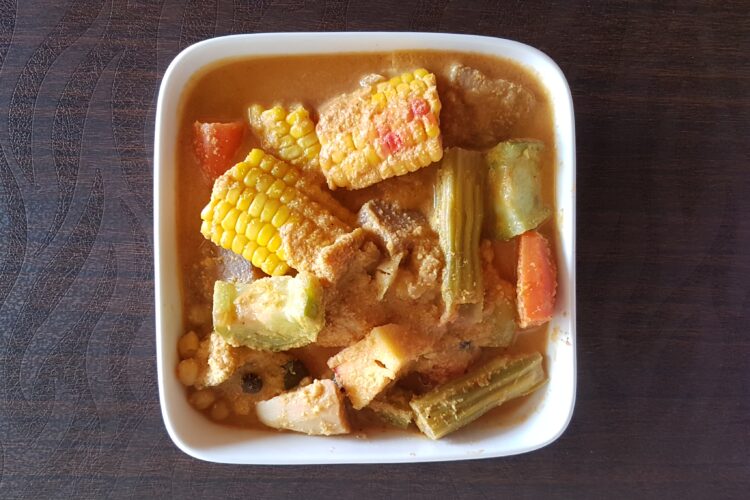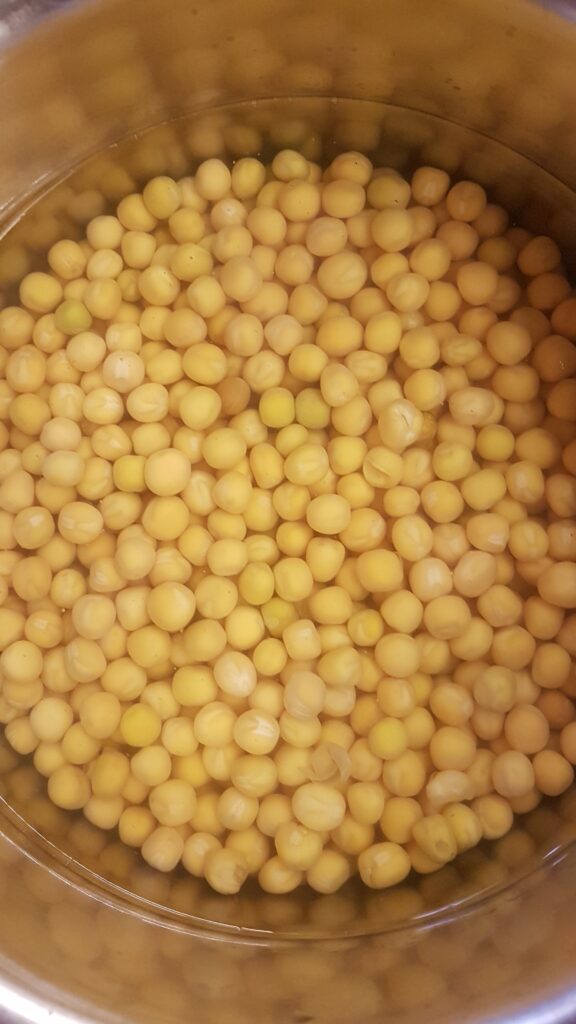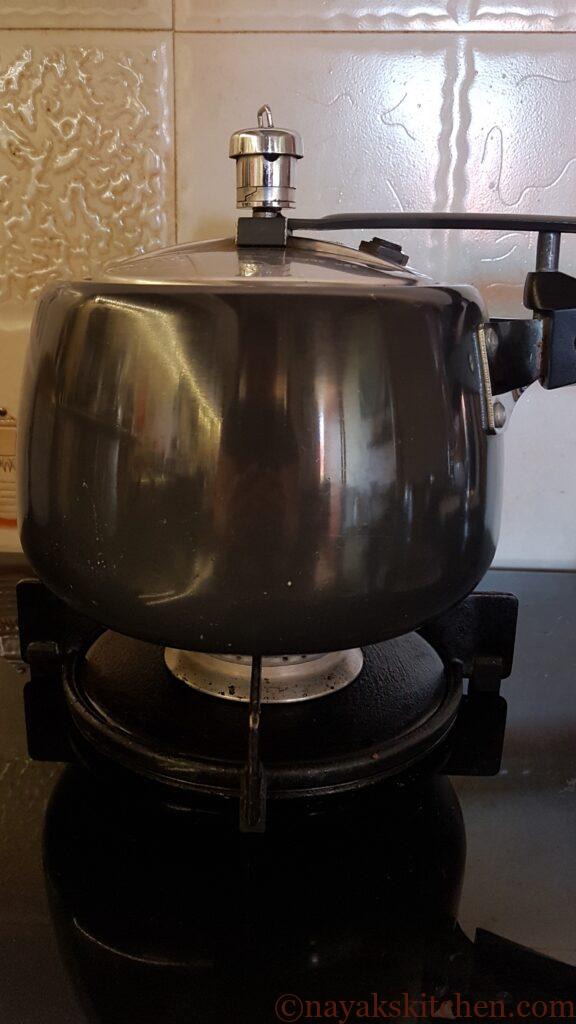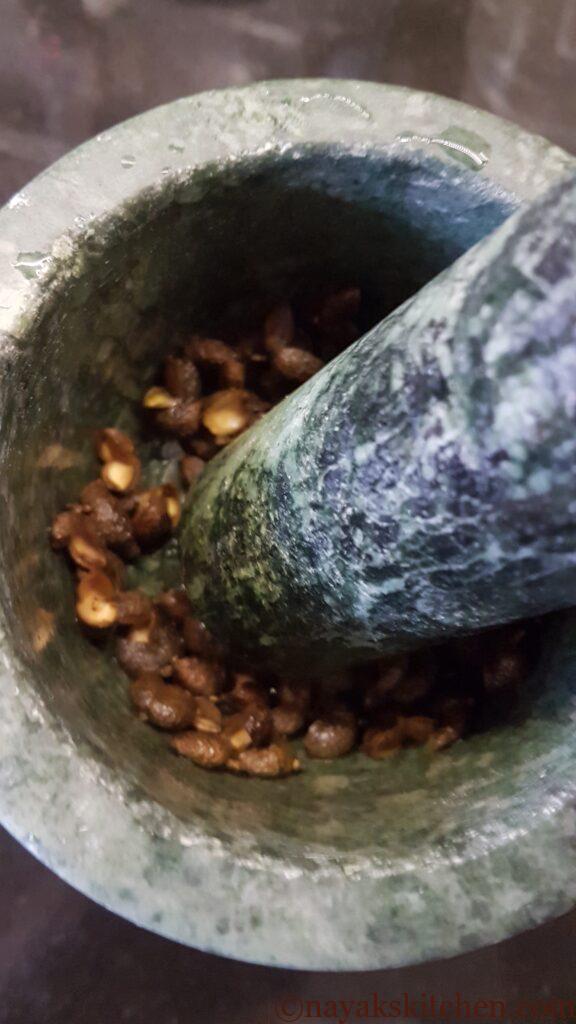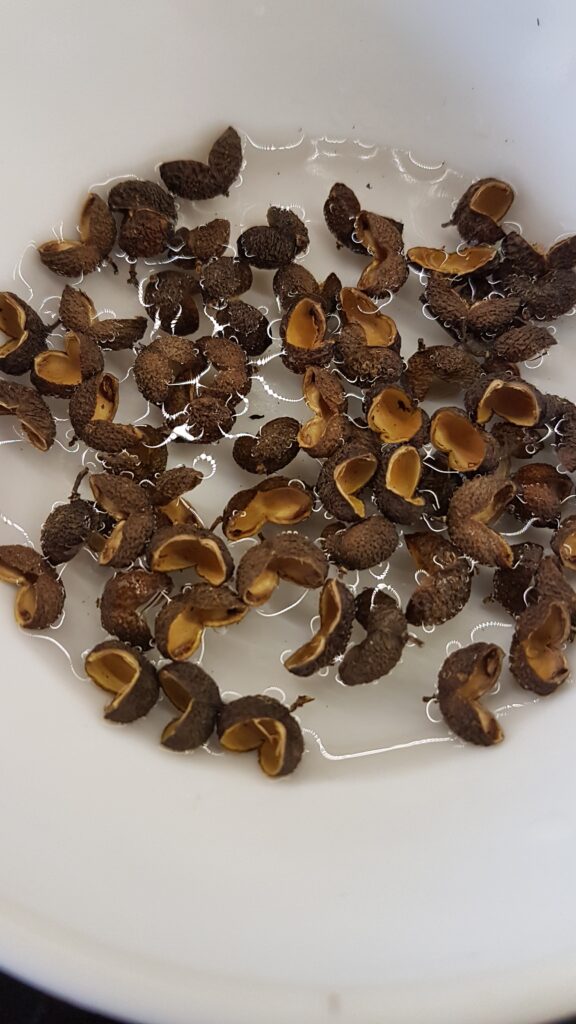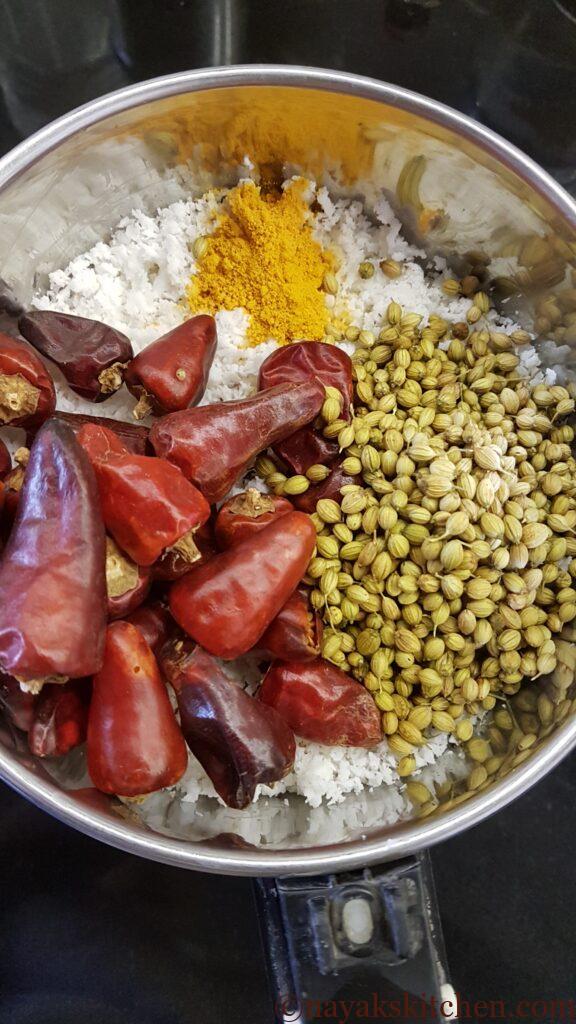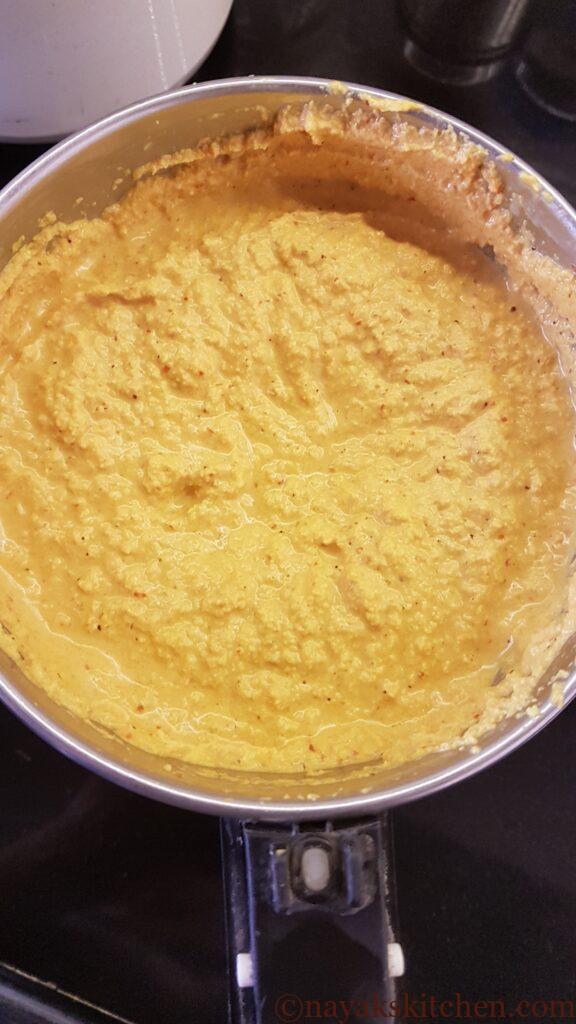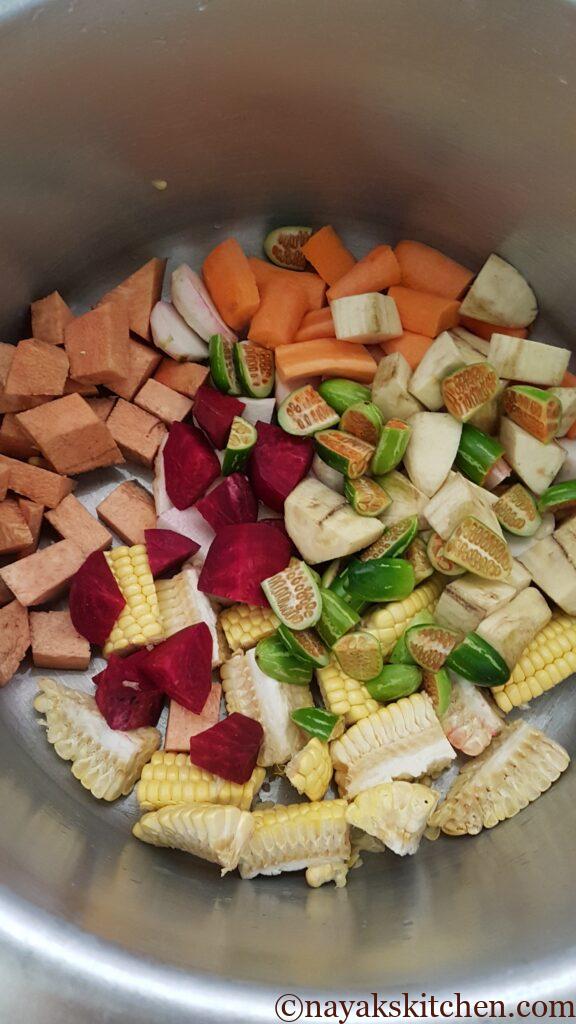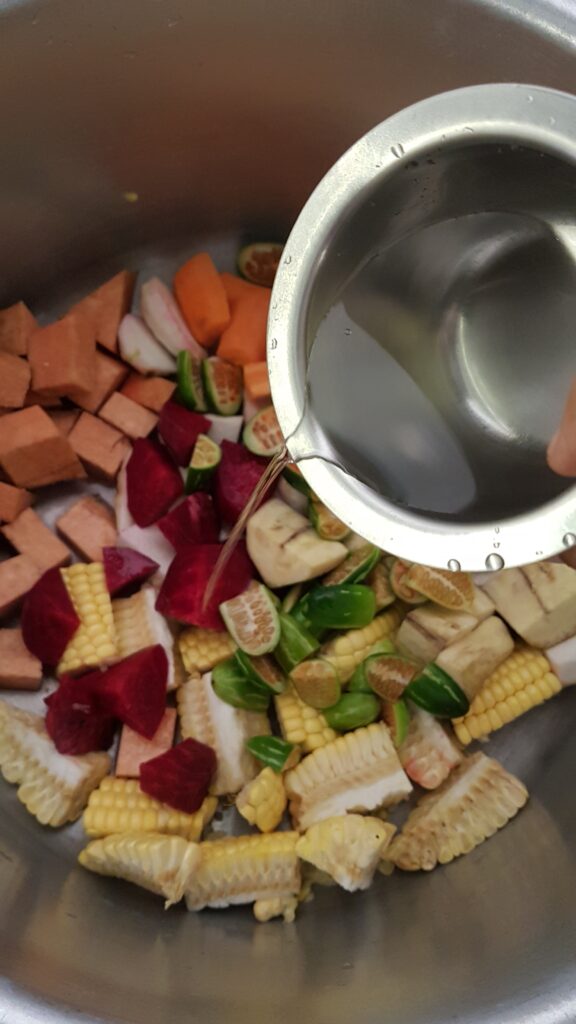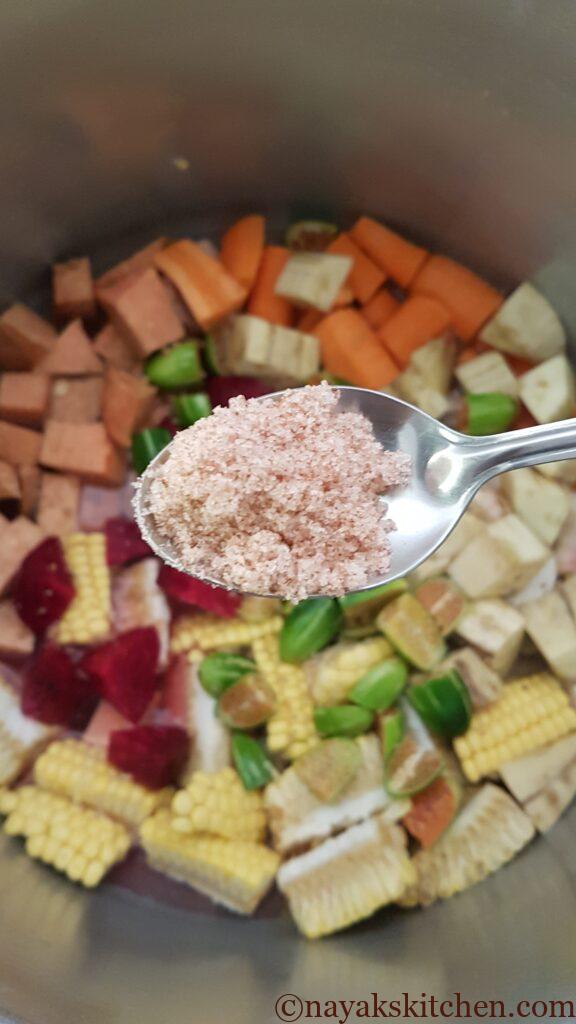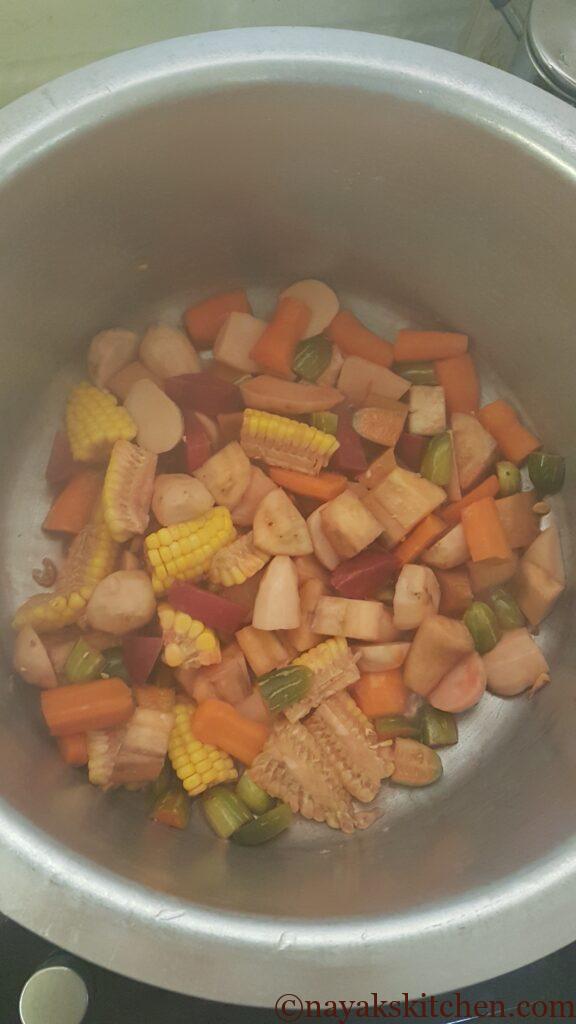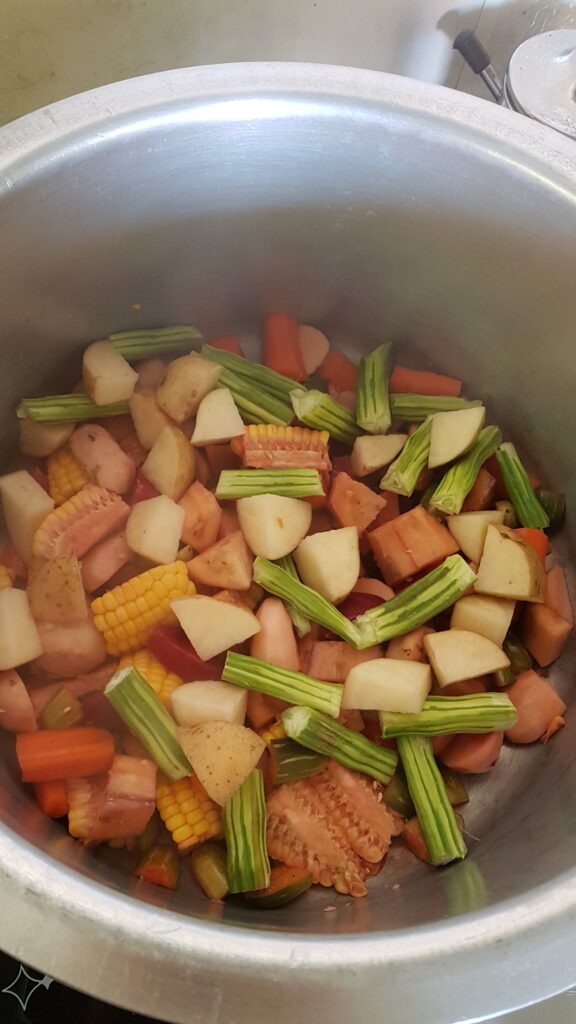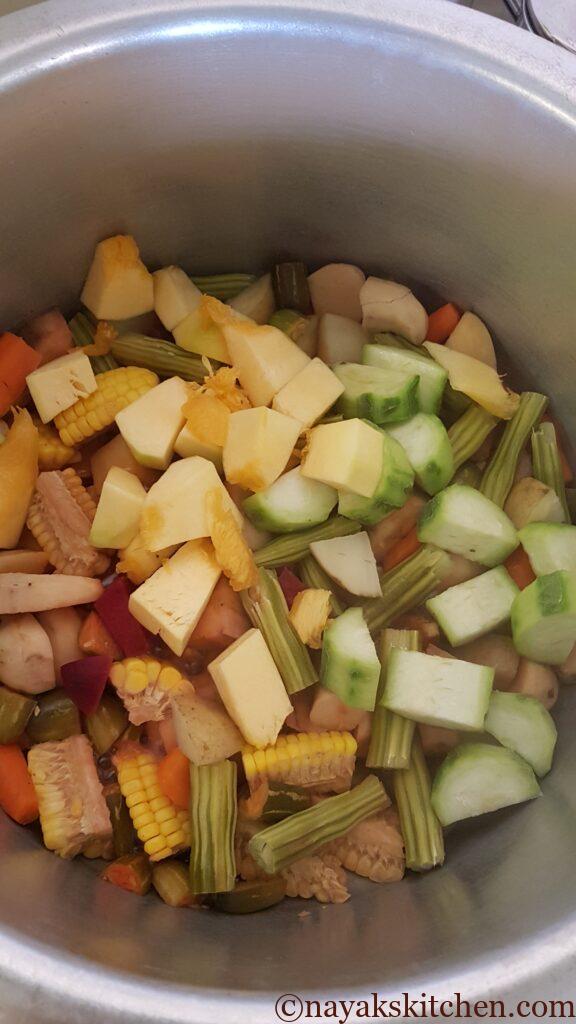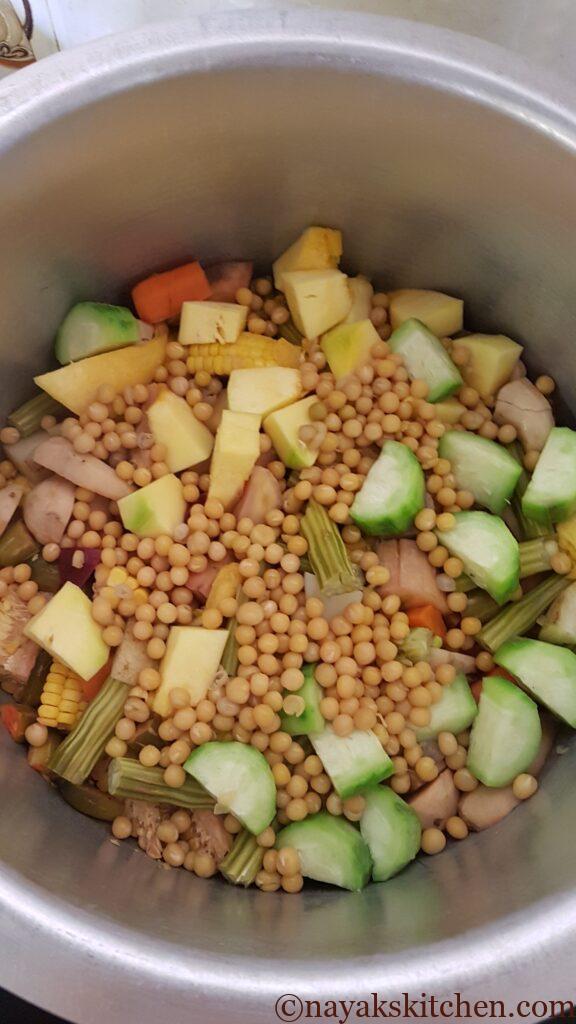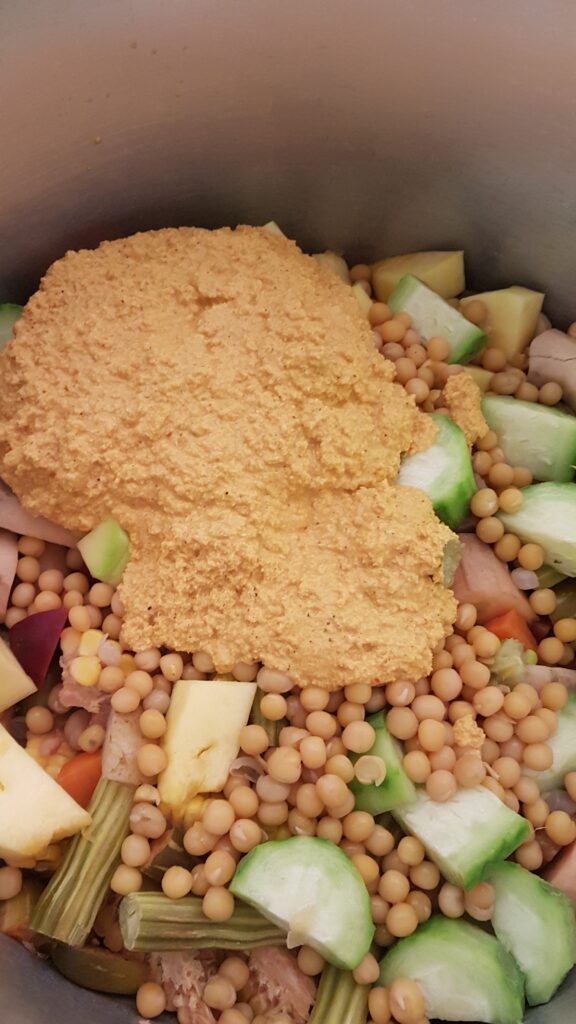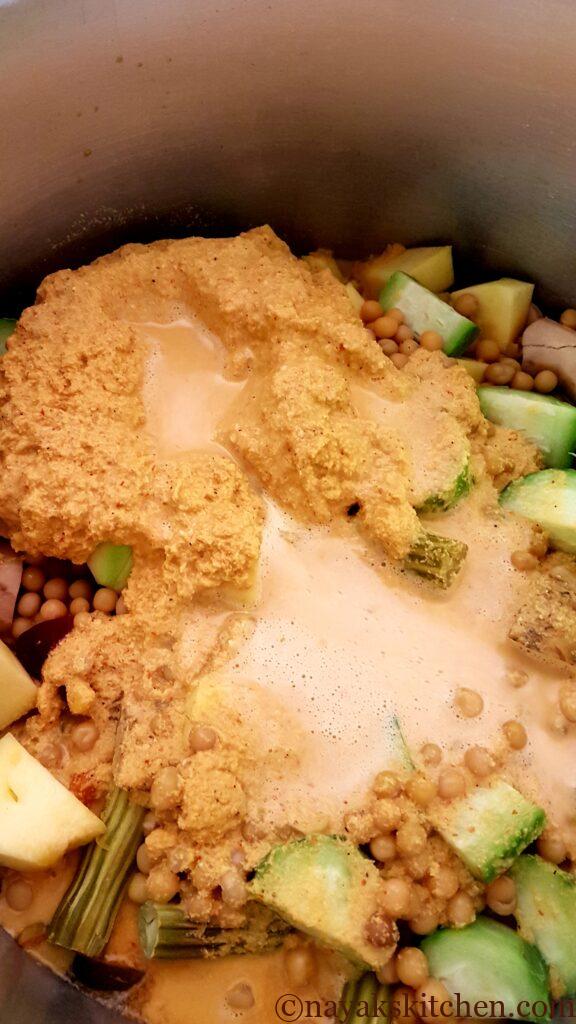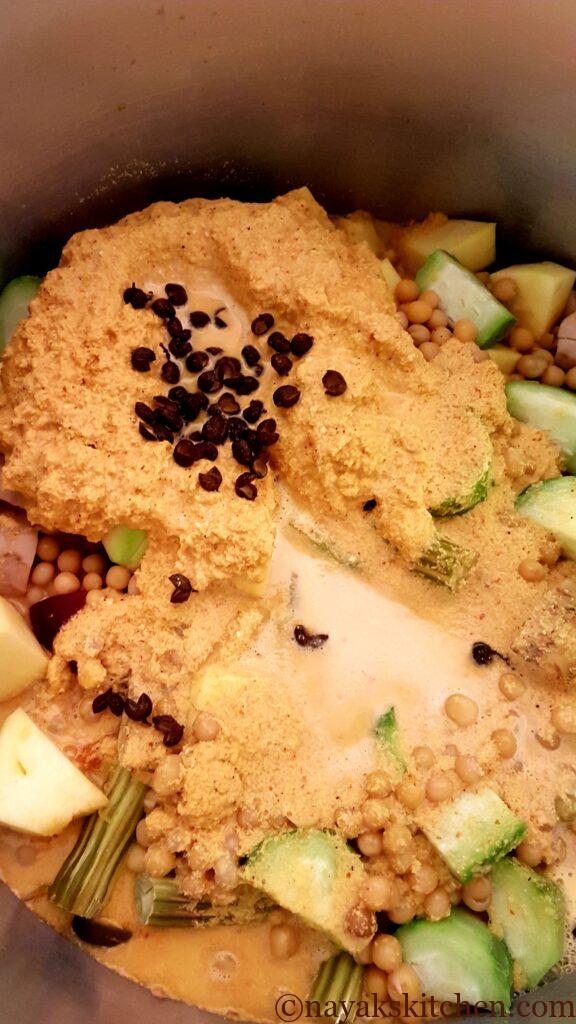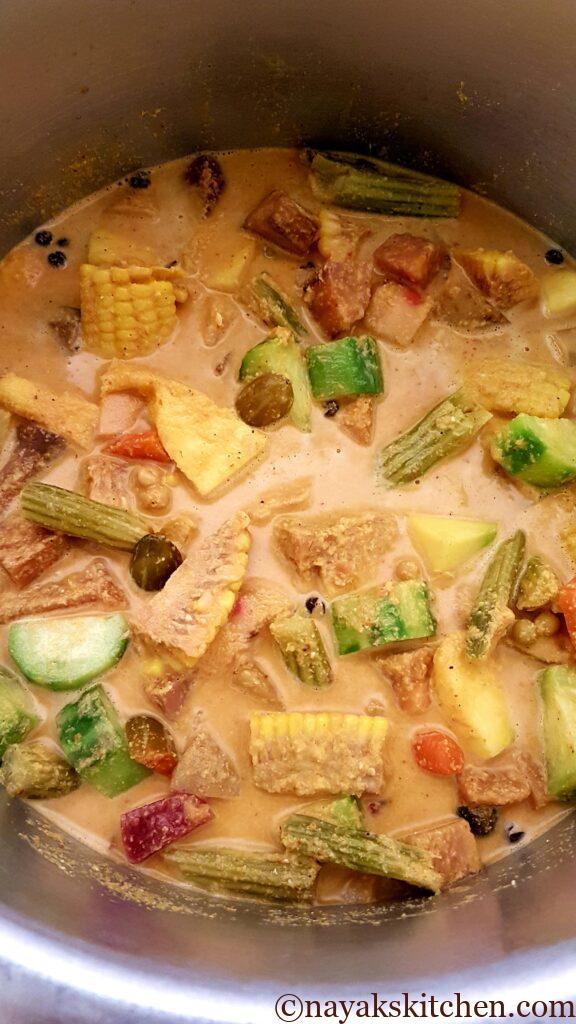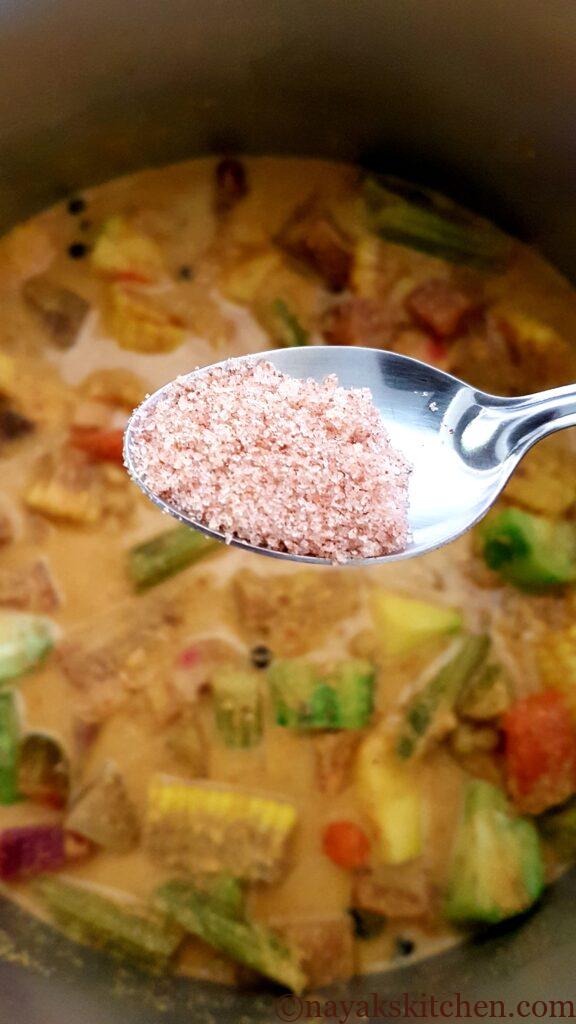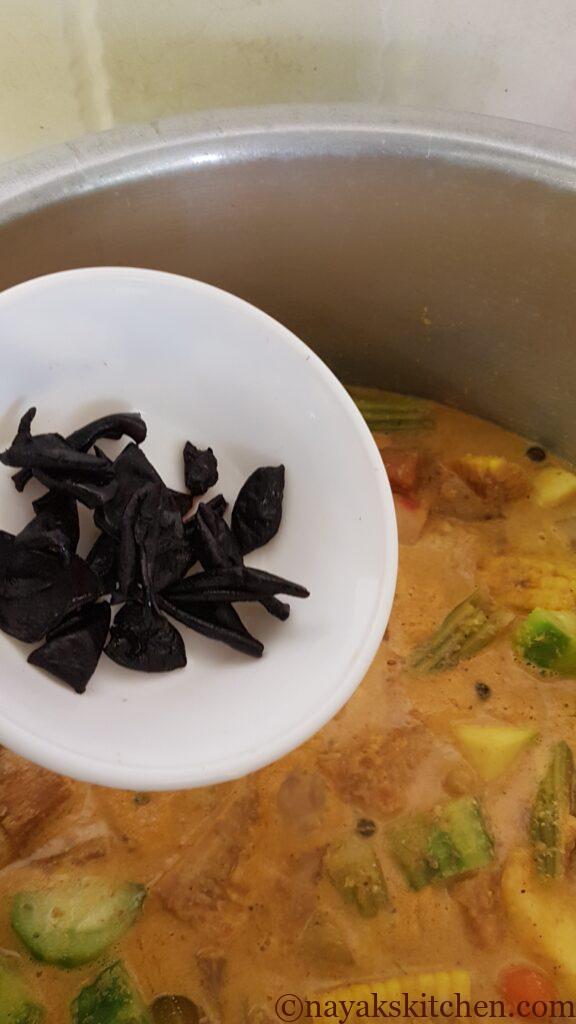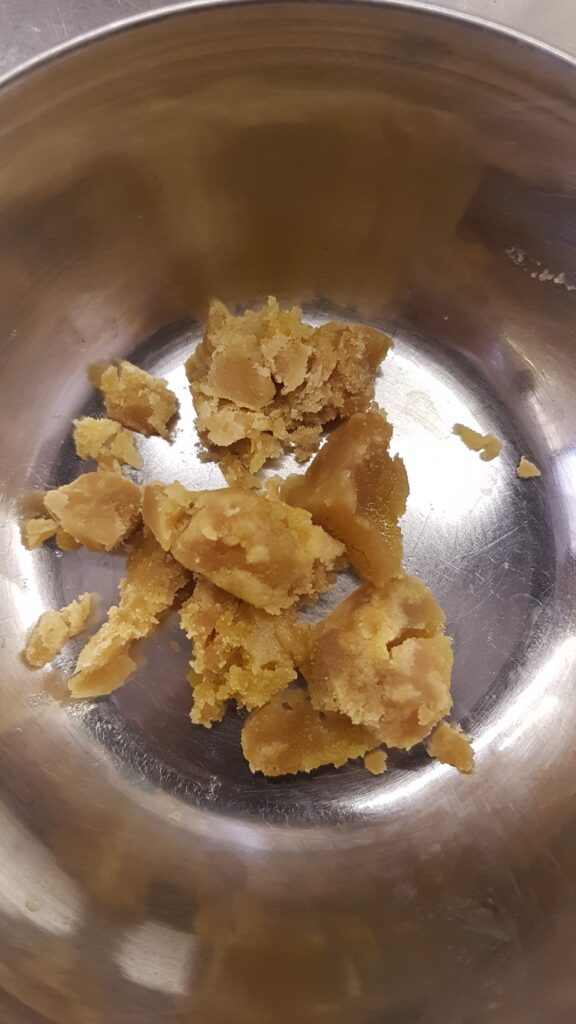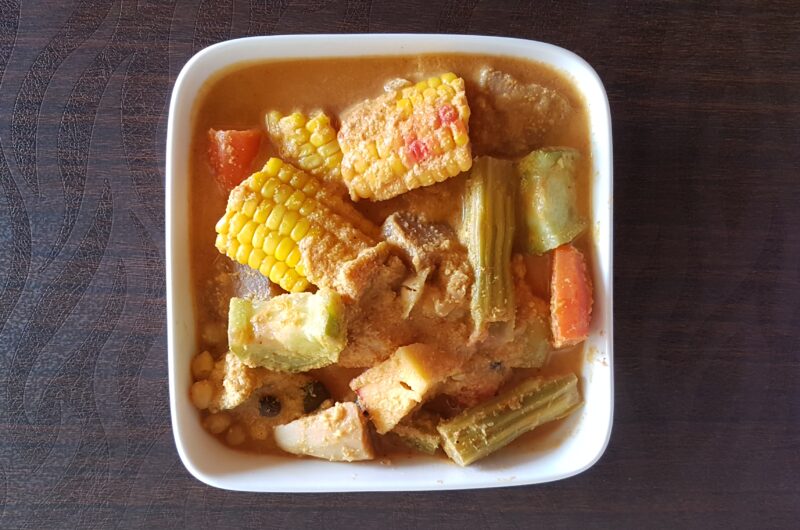Khatkhate recipe with step-by-step photos and instructions.
Khatkhate! The classic Goan vegetarian dish. A few recipes, unquestionably, always remain true and exclusive to a certain cuisine. You will not find anything close or similar to it. Khatkhate is one of those culinary delights of Goan cuisine. It is similar to ‘Avial’ a South-Indian mixed vegetable stew. However, Avial uses curd unlike Khatkhate.
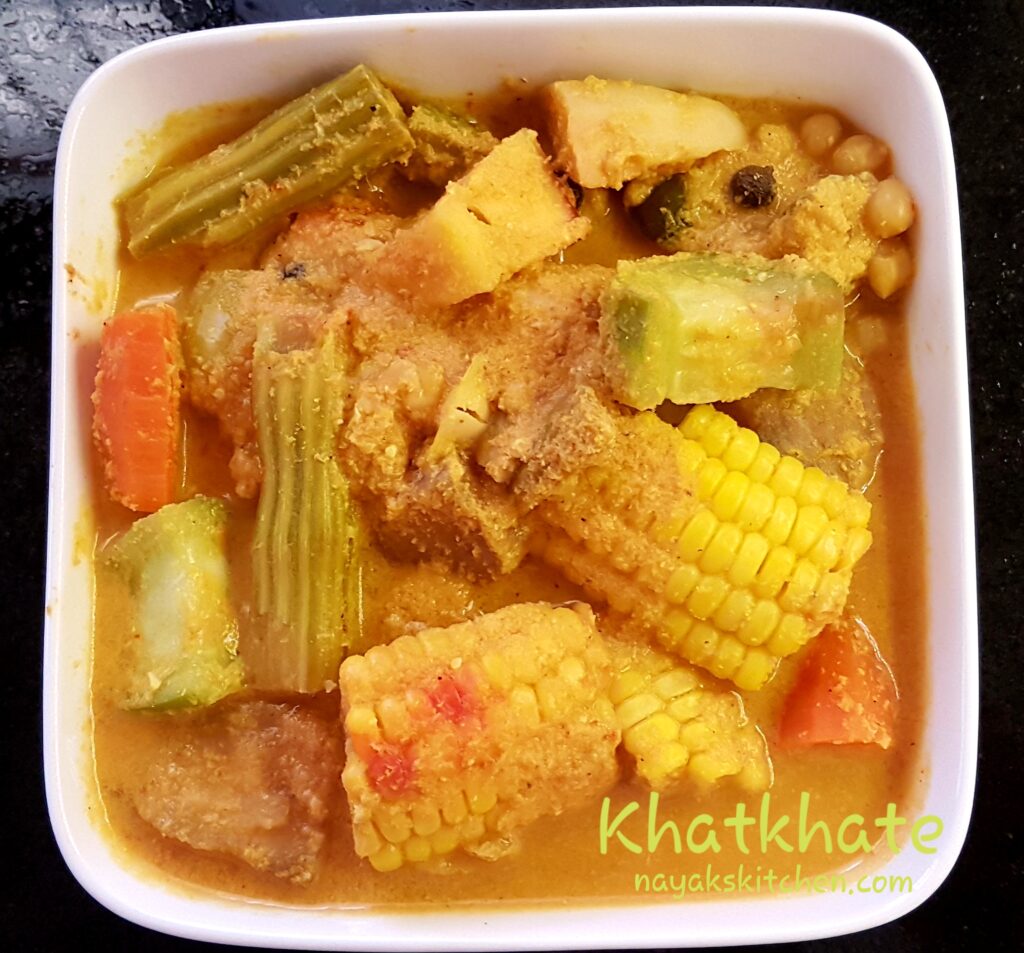
Khatkhate is commonly made along the west coast of India in the Konkan regions, Goa and Karnataka. It is prepared during many religious festivities, weddings, pujas and auspicious ceremonies. In fact, it is one of the main dishes prepared on the occasion of Ganesh Chaturthi.
Although traditional, it is one of the simplest recipes that you can try hands on. It is a mild spicy curry with a hint of sweetness. Diverse veggies impart this subtle sweetness. No exotic ingredients, yet a foodie’s delight. Above all, healthy and nutritious too.
However, keep in mind some very important pointers when preparing this flavourful dish. Do read this post till the end to understand what goes in, to making a perfect ‘Khatkhate’.
What is Khatkhate?
Khatkhate is a mixed vegetable curry (more like a stew) prepared using different local and seasonal vegetables. Moreover it is a splendid medley of varied flavours and tastes. Spicy (but not hot), tangy, a dash of sweetness and lemony overtones is what makes Khatkhate irresistible.
Khatkhate pairs perfectly with steaming hot rice. Moreover you don’t even require an accompaniment. To sum up, the different vegetables will satiate you and keep you full.
Khatkhate closely resembles a mixed vegetable stew. A stew is a combination of solid food ingredients. Here a mixture of big chunks of veggies is covered with just enough water. It is further simmered or slow-cooked over low heat for a longer period of time.
Slow cooking brings out the best flavours and nutrition of the veggies. Once the vegetables cook, a simple coconut paste is added. Additionally, kokum gives a slight tang not disturbing the original taste. A small piece of jaggery is added to balance all the flavours.
The indispensable ingredient for Khatkhate
The star ingredient in Khatkhate is undoubtedly the tefla. Specifically, its signature taste, unique flavour and aroma is what makes Khatkhate distinct. Without tefla, Khatkhate cannot be authentic. Tefla, Teppal or Tirphal is a revered culinary ingredient. It is an integral part of the coastal cuisine.
To know more further, about this indigenous spice, refer to my post below.
Characteristics of Khatkhate
Khatkhate has certain basic characteristics or features. It is mandatory to follow these aspects to make it authentic.
- Firstly, onion or garlic are not used in the recipe.
- Tefla (west coastal spice) is an essential ingredient. It is the distinctive taste of this spice that makes Khatkhate appetizing. Hence, tefla are indispensable. Also, there is no substitute to tefla. Such unique is its taste.
- Traditionally, there is a predefined list of vegetables for Khatkhate. Most of them are local and seasonal.
The Healthy Khatkhate
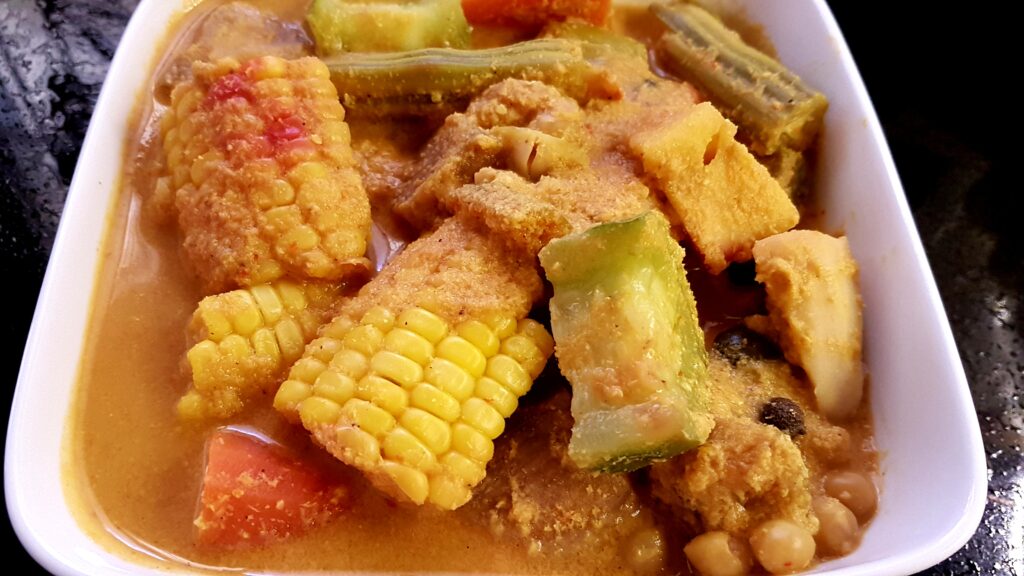
Khatkhate is undeniably one of the most healthiest. Here, a platter of assorted vegetables go into the making this culinary delight. How many times do we really think of preparing something with roots or tubers?
Green papaya, tender jackfruit, yams also remain on the backfoot. Hence, Khatkhate gives you an opportunity to include all the lesser-known vegetables in your diet. It is a traditional recipe that includes the best of seasonal fare. Above all, no oil is used in Khatkhate.
List of vegetables used
Yes. There is a predefined list of vegetables. Not that you cannot include other veggies. But then, it is a conventional recipe and the taste does matter on the vegetables, you choose to include. Besides taste, it is very important that the vegetables retain their structure upon cooking. Roots and tubers fit the bill well.
Don’t worry it is a quite a big list. Try to include atleast minimum 5-7 varieties from the provided list. Nevertheless, you can include maximum available vegetables. I have included 11 vegetables in this recipe.
- Potatoes
- Pumpkin (Dudhi)
- Carrots
- Beetroots
- Drumsticks
- Ivy Gourd (Tendli)
- Tender Jackfruit
- Breadfruit
- Green Papaya
- Sweet Potatoes
- Suran (Elephant Foot Yam)
- Sweet Corn
- Arbi
- Ridge Gourd
- Green Banana
Vegetables not used in Khatkhate
Khatkhate does not include certain vegetables. This is primarily because of their taste and basic nature upon cooking. For example, ladies finger will turn your Khatkhate slimy and sticky.
To sum up avoid using the following vegetables:-
- Ladies Fingers
- Bitter gourd
- Ash gourd
- Any type of leafy vegetables
- Brinjals
- Onions
- Ginger or garlic
Some Tips
- Use a wide and deep bottomed pan for easy stirring of vegetables.
- Do not stir much during the process of cooking else you will end up with a pulp of veggies.
- White peas can be substituted with tur dal (split pigeon peas).
- Vegetables have to be cooked as per their cooking time. For instance, carrots, beetroots, arbi, suran etc. go in first as they take longer to cook. On the contrary, pumpkin, ridge gourd etc. are added last as they have a shorter cooking time.
- Vegetables have to be cut in large size chunks so that they retain their shape upon cooking.
- Tefla is a crucial and necessary ingredient as already mentioned above.
- If you do not have kokum, use a small piece of tamarind (about a teaspoon) while grinding the coconut paste.
- Certain tubers like suran cause itching of fingers. Be careful while chopping them.
- The gravy of Khatkhate should not be runny. It should be of thicker consistency.
How to prepare Khatkhate?
- Soak white peas for 6-7 hours or overnight. Pressure cook along with the water, adding a little salt and hing (asafoetida), for 3-4 whistles or until soft.
2. Crush tefla in a mortar pestle and soak in a little water. Keep aside.
3. Chop all the vegetables to big size chunks. Wash potatoes well and chop with skin intact. Peel drumsticks and chop into finger size sticks. Chop corn into small quarters. Cut tendli (ivy gourd) into quarters. Peel and chop remaining veggies.
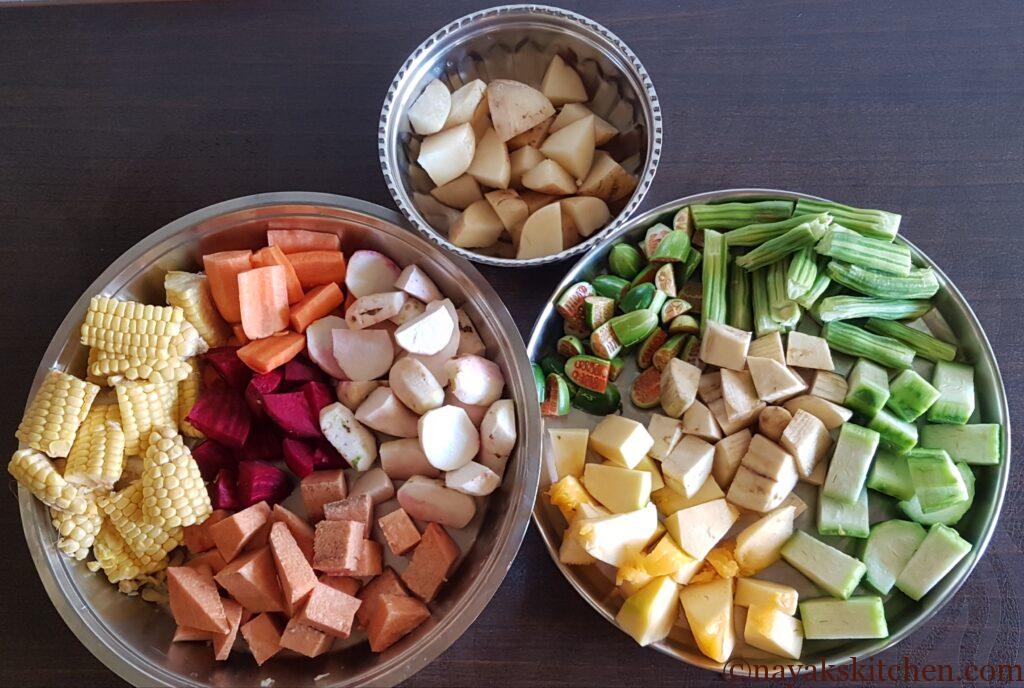
4. Grind grated coconut, red chillies, coriander seeds and turmeric to a paste.
Steaming the vegetables
4. Take a wide and deep bottomed vessel. First add those vegetables that have a longer cooking time. For example, suran (elephant foot yam), carrots, beetroots, green banana, arbi, corn etc. Arrange all the vegetables and add 2 cups of water.
5. Next switch on the gas and keep on medium flame. Add salt. Cover and steam till the veggies are 80% cooked.
6. Next add drumsticks and potatoes. Cook covered for another 10 mins. Finally add pumpkin and ridge gourd. These two vegetables cook very fast and hence are added last. All vegetables should be cooked in a manner such that they retain their shape and structure. Upon piercing a knife it should slide in easily. If you overcook the vegetables they will become very mushy and turn into a pulp.
7. Next add cooked white peas and coconut paste.
8. Add water to adjust the consistency of the gravy. Also add crushed tefla along with the water in which it was soaked.
9. Mix everything well. Do not mix vigorously. Adjust the thickness of gravy. Khatkhate gravy should be slightly thick and not watery. Add a little salt (keep in mind you have already added salt in the beginning while cooking the veggies).
10. Finally, add kokum and jaggery. However, mix everything well slowly. Allow to cook for about 5 mins and then switch off the gas.
11. Serve Khatkhate with steaming hot rice.

Khatkhate | Goan Mixed Vegetable Curry (Stew) | How to make Goan Khatkhate?
Course: Main CourseCuisine: GoanDifficulty: ModerateKhatkhate is a mixed vegetable curry (more like a stew) prepared using different local and seasonal vegetables.
Ingredients
1 CUP = 250 ml
1 tbsp = 15 ml
1 tsp = 5 ml
- For the gravy (Grind to a paste)
Coconut (grated) – 2 cups or 1 medium-size coconut
Red chillies – 15 nos. (Preferably Goan variety)
Turmeric powder – 1/2 tsp
Coriander seeds – 1 tbsp
Water – as required (to grind and adjust consistency of gravy)
- Mixed Vegetables (Refer to list above for more variety)
Potatoes – 1 no. large
Carrots – 2 nos. (medium-size)
Beetroot – 1 no.
Suran (Elephant foot yam) – 1 cup
Arbi (Yam) – 4-5 nos.
Sweet Corn – 1 no.
Green Banana – 1 no. (small)
Tendli (Ivy Gourd)
Pumpkin – 1 cup
Ridge Gourd – 1 cup
Drumsticks – 2 nos. (peeled and chopped to finger-size pieces)
Water – 2 cups (to steam)
- Other Ingredients
White peas – 1/4 kg
Tefla/Tirphal/Teppal – 15-20 nos.
Kokum – 6-7 nos.
Jaggery – 1 tbsp
Salt – as per taste
Directions
- Soak white peas for 6-7 hours or overnight. Pressure cook with a little salt and hing (asafoetida) for 3-4 whistles or until soft.
- Crush tefla in a mortar pestle and soak in a little water. Keep aside.
- Chop all the vegetables to big size chunks. (Wash potatoes well and chop with skin intact. Peel drumsticks and chop into finger size sticks. Chop corn into small quarters. Cut tendli (ivy gourd) into quarters. Peel and chop remaining veggies.)
- Take a wide and deep bottomed vessel. First add those vegetables that have a longer cooking time. For example, suran (elephant foot yam), carrots, beetroots, green banana, arbi, corn etc. Arrange all the vegetables and add 2 cups of water.
- Next switch on the gas and keep on medium flame. Add salt. Cover and steam till the veggies are 80% cooked.
- Next add drumsticks and potatoes. Cook covered for another 10 mins.
- Finally add pumpkin and ridge gourd. These two vegetables cook very fast and hence are added last.
- All vegetables should be cooked in a manner such that they retain their shape and structure. Upon piercing a knife it should slide in easily. If you overcook the vegetables they will become very mushy and turn into a pulp.
- Next add cooked white peas and coconut paste.
- Add water to adjust the consistency of the gravy. Also add crushed tefla along with the water in which it was soaked.
- Mix everything well. Do not mix vigorously. Adjust the thickness of gravy. Khatkhate gravy should be slightly thick and not watery. Add a little salt as you have already added in the beginning while cooking the veggies.
- Add kokum and jaggery. Mix everything well slowly. Allow to cook for about 5 mins and then switch off the gas.
- Serve Khatkhate with steaming hot rice.
Notes
- You can use vegetables as per your choice from the list provided. Try to include atleast minimum 5-7 varieties from the provided list. I have included 11 vegetables in this recipe.
- Use a wide and deep bottomed pan for easy stirring of vegetables.
- Do not stir much during the process of cooking else you will end up with a pulp of veggies.
- White peas can be substituted with tur dal (split pigeon peas).
- Vegetables have to be cooked as per their cooking time. For instance, carrots, beetroots, arbi, suran etc. go in first as they take longer to cook. On the contrary, pumpkin, ridge gourd etc. are added last as they have a shorter cooking time.
- Vegetables have to be cut in large size chunks so that they retain their shape upon cooking.
- Tefla is a crucial and necessary ingredient as already mentioned above.
- If you do not have kokum use a small piece of tamarind (about a teaspoon) while grinding the coconut paste.
- Certain tubers like suran cause itching of fingers. Be careful while chopping them.
- The gravy of Khatkhate should not be runny. It should be of thicker consistency.
